Bílina
Bílina (Czech pronunciation: [ˈbiːlɪna]; German: Bilin) is a town in the Teplice District in the Ústí nad Labem Region of the Czech Republic. It is known for its spas and as a source of the strongly mineralized water, Bílinská kyselka (German: Biliner Sauerbrunn; French: Eau de Bilin).
Bílina | |
|---|---|
Town | |
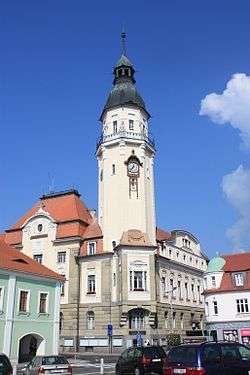 Town hall | |
 Flag 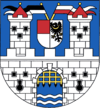 Coat of arms | |
| Etymology: white water/river | |
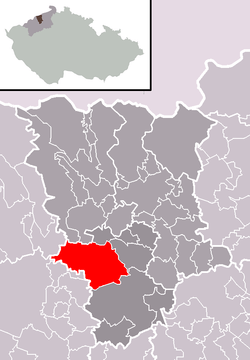 Location in Teplice District | |
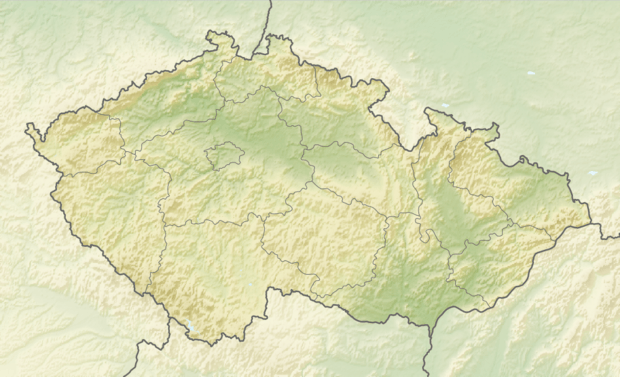 Bílina Location in the Czech Republic | |
| Coordinates: 50°32′53″N 13°46′34″E | |
| Country | Czech Republic |
| Region | Ústí nad Labem |
| District | Teplice |
| Founded | 10th century |
| Government | |
| • Mayor | Zuzana Schwarz Bařtipánová (ANO) |
| Area | |
| • Total | 32.39 km2 (12.51 sq mi) |
| Elevation | 214 m (702 ft) |
| Population (2019-01-01[1]) | |
| • Total | 17,166 |
| • Density | 530/km2 (1,400/sq mi) |
| Time zone | UTC+1 (CET) |
| • Summer (DST) | UTC+2 (CEST) |
| Postal code | 418 01 |
| Website | www.bilina.cz |
Name
The name of the town originates from the adjective "white" (bielý in Old Czech). The term Bielina ("white/bald place") is etymologically derived either from fact there was an area without any wood or (maybe) from sparkling waters of the river Bílina (formerly called Bělá).
History
Middle Ages
During the 10th century, the era of making Bohemian (Czech) state, a gord (Slavonic fortified settlement) was built here by Bohemian rulers as a defence point against German raids from neighbouring Saxon Eastern March (part of the Holy Roman Empire). The first written mention of the settlement, then a seat of a province (Latin: provincia Belinensis), dates back to 993 and comes from the Chronicle of Bohemians, which describes a battle between duke Bretislaus I and the German emperor Henry III near the gord.
Before the half of 13th century knight Ojíř of Friedberk built a new castle in the settlement, which was expanded into a mediaeval town with bulwarks and three gates.
Since the 2nd half of the 13th century German settlers were called into the border areas of the Bohemian Kingdom, introducing German town law; it was also the case with Bílina town which is first mentioned as a regular chartered town (civitas) in 1289.
In 1420 Bílina was kept by lord Albrecht of Koldice, well known for his anti-Hussite attitude. Thus, Bílina was surrounded and conquered by a Hussite hejtman Jakoubek of Vřesovice who returned Bílina to the Koldice family in 1436 and lords of Koldice kept the town until 1495.

After 1502, the town of Bílina was owned by the aristocratic family of Lobkowicz who later built on the place of Gothic castle a new chateau, designed by Swiss-Italian architect Antonio della Porta.
20th century
From October 1938 to May 1945 the town (with 60% of German inhabitants) was one of the municipalities in Sudetenland, part of the territory that Nazi Germany broke away from Czechoslovakia. During this period, Bílina was administered as a part of the Regierungsbezirk Aussig of Reichsgau Sudetenland. After the liberation of Czechoslovakia, almost all Germans from the town (and whole borderland area too) were expelled. The decline in population was replaced after the war by immigrants of Czech origin from Volhynia and Balkans, as well as Slovaks and Gypsies.
Another turning point in the history of town was a changeover in 1989, after the end of the Communist regime. Descendants of Lobkowicz family regained a part of their original property, including the spa; the spa was later sold to a private company.
Founding and bloom of spa
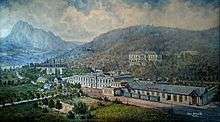
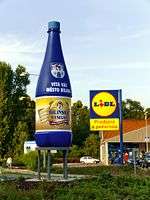
Local springs of delicious mineral water began to be systematically exploited already in 1664. In 1702 Princess Eleonore of Lobkowicz had the mineral spring cleaned and the very first spa guests began to visit. By the end of 19th century the spa Biliner Sauerbrunn (meaning "Carbonated springs of Bílina" in German) had become the pride of the town. Bílina also received the nickname "Vichy of Germany". The digestive pastilles produced here also provided a worldwide common name for digestive regulators and laxatives: "Seidlitz Powders." The lozenges were made from the spring's mineral water Sedlitz bitter water, which was also used in the local spa balneology.
Scientific descriptions of the medicinal properties of local water treatment have contributed to the works of significant balneologists, including Franz Ambrosius Reuss, August Emanuel von Reuss and Josef von Löschner. Father and son Reuss are depicted in the spa Bílina memorial, which dominates the spa's central park.
In 1878 a large spa complex was built in a Renaissance Revival style, designed by the Lobkowicz family architect and builder Franz Sablik. Above the main spring, called "Joseph's Spring" (Josefs Quelle in German), a so-called spring temple was built, which protected it from the influences of the surroundings and at the same time allowed visitors to gather water as it was common in other European spas. Another building became popular among visitors: Forest Café, built as a timber pavilion in Swiss mountainous style.
4,315,300 bottles of Bílinská kyselka mineral water were exported in 1900, the biggest importer being Germany and Russia. The most distant country where water was exported was Brazil (Rio de Janeiro).
Geography
The town of Bílina is situated in the northwestern Bohemia, lies in the valley of the Bílina River between the Central Bohemian Uplands and the Ore Mountains. It is situated between two bigger cities: Teplice and Most.
The town is dominated by two features: the steep hill Bořeň 1 km south (from a certain point of view it resembles a lying lion) and the close proximity of the giant brown coal mine Bílina which seriously changed and damaged surrounding landscape.
Places of interest
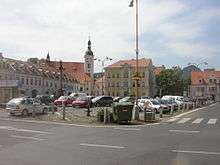
- Lobkowicz château – built in the years 1675–1682 on the site of an earlier Gothic castle
- Hussite bastion – a remnant of the massive town fortifications
- Town Hall – an Art Nouveau building built at the beginning of the 20th century, is the town's pride
- Bílinská Kyselka Spa – a spa complex including the spring house of the mineral waters, cafes and natural amphitheater in a forest setting
- Bořeň – a large phonolite mountain, dominating the city and its surroundings
- St. Peter and Paul's church – parish church and historic monument
Culture and sport
The town boasts a modern stadium. In the new millennium a new ice-hockey hall was also built. The swimming pool dates from 1931.
Notable people
- Johann Adalbert Angermeyer, German Bohemian painter
- August Emanuel von Reuss, Austrian geologist
- August Leopold von Reuss, Austrian ophthalmologist
- Gustav Walter, Austrian opera singer
Twin towns — sister cities
Bílina is twinned with:[2]
References
- "Population of municipalities of the Czech republic". Czech Statistical Office. Retrieved 2019-04-30.
- "Partnerská města" (in Czech). Město Bílina. Retrieved 2019-08-23.
External links

- Official website (in Czech)